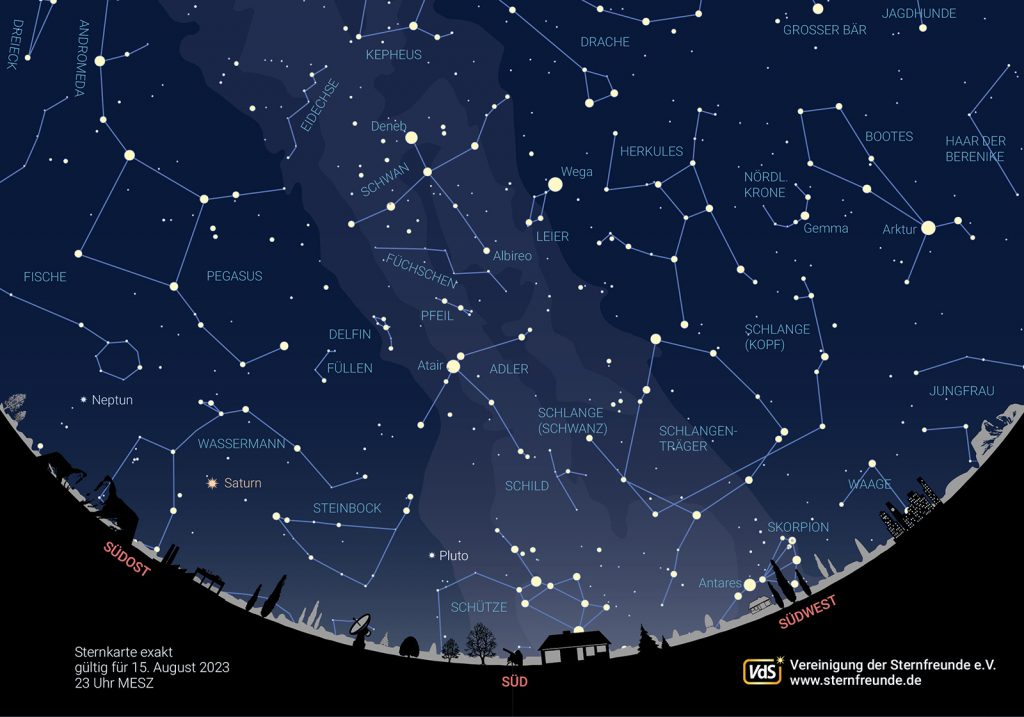The starry sky in August 2023
Every year in August, countless shooting stars, the Perseids, can be observed. They get their name from their apparent origin in the direction of the constellation Perseus, which slowly rises above the eastern horizon during the month. The maximum with up to 100 star clusters per hour is expected this year on the morning of August 13. It is not uncommon to see so-called fireballs or bolides with a brightness comparable to the brightest stars. The Perseids originate from a cloud of dust particles left behind by the comet Swift-Tuttle, which was discovered in July 1862 on its 133-year journey around the sun.
As Meteoride are small objects in space that are created, for example, by collisions of asteroids or eruptions from comets. If these enter the earth's atmosphere, they become a meteor or shooting star. When they reach the Earth's surface, they are called meteors.te. Meteorites from the moon and Mars have also been detected.
On the occasion of this year's Perseids, the observatory will open from 9 p.m., weather permitting, and offer a Lecture offer.
SUN AND MOON
August shows us the most beautiful starry sky in summer. Sunsets in Zweibrücken continue to be earlier from 21:08 CEST at the beginning of the month to 20:13 on the 31st of the month. Only at the end of the month will the full moon cloud the view of the night sky, which will hopefully be clear at that time, for a few days. On the 3rd and 30th, the moon will be close to the planet Saturn in its position. We will miss the event on the 3rd as it will take place in the daytime sky. The event on the 30th will take place in the evening hours. At 22:00, the distance between the Moon and Saturn will be approx. 3.3 degrees.
PLANETS
Mercury cannot be observed in our latitudes. Only in southern climes is it worth keeping an eye out for it in the evening sky.
Venus changes sides and reappears in the morning sky later in the month.
Mars has finally said goodbye to the evening sky, it is invisible to us for the whole month.
Jupiter continues to rise early. Towards the end of the month, it appears in the evening sky at 22:30. With a brightness of -2.6m, it becomes the dominant star.
Saturn finally ends the planet-poor period. It is in opposition to the Sun on the 27th of the month. On this day, it crosses the horizon at around 8:10 pm. Despite the relatively small ring aperture of around nine degrees, it is an impressive sight even in smaller telescopes.
Uranus cannot be observed in August until the end of the month. It rises at 22:40 in the eastern sky.
Neptune accelerates its movement and approaches the opposition position, which it reaches on September 19.
STARRY SKY
On Eastern sky the constellation Pegasus, a winged horse that has been known since ancient times, rises. The King's Poke Andromeda is still close to the horizon.
The Southern sky shows us Sagittarius, which is not very prominent in our latitudes, and Capricorn, while Scorpio is already approaching the horizon again.
Furthermore western night sky Bootes, the bear's keeper, can still be observed with the bright star Arcturus.
About us the band of the Milky Way with the summer triangle can now be seen in its full splendor in areas with less light.
The big bear, which according to mythology is actually a female bear, was born on northern night sky. In our latitudes, the constellation is circumpolar, i.e. it never sets. It is often referred to as the Big Dipper because of its appearance. The two rear box stars are often used as a guide to locate Polaris. This leads to the north celestial pole in approximately fivefold extension.

